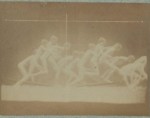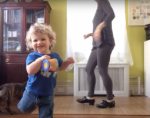
Photo: Paul Kolnik
Love Beyond the Grave: A "Giselle" Fan and a Neophyte Talk
by Lynn Matluck Brooks and Lisa Kraus
Lynn Matluck Brooks and Lisa Kraus spent a recent Sunday afternoon watching Pennsylvania Ballet’s Giselle with performances by Zachary Hench as Albrecht and tD Writer Julie Diana in the main role. Here is some of the conversation they recorded afterwards:
Lisa: You saw PA Ballet’s first production of Giselle 24 years ago and are quite a Giselle fan. Is there a progression in your relationship to the ballet? And does PA Ballet look different performing it 24 years later?
Lynn: I thought the staging was very fine this time. It was in the Academy, as opposed to the Merriam, which really supports the flavor of the work much better. The sets were beautiful. The lighting was mysterious. There was a real three-dimensionality to the stage that I don’t remember from the last time.
Because I’ve watched the piece over and over and in different performances, I keep being aware of two strains of thought. One is that this is very silly from a modern point of view. It seems in some ways superficial not to question matters so potent for us today that are evident in the work: class and gender and all kinds of issues like that. On the other hand, Giselle continues to move me with the universality of the moral of love enduring all, love beyond the grave, which I still—maybe I’m an antique—but I still find that very moving and the ballet continues to affect me. I tear up at the appropriate moments every time. So it’s like I watch it with two souls.
Lisa: As a person who’s never seen it before, I also found myself very moved and I felt it had to do with an extremely effective performance. Yes, the text is there in the scenario, but to really communicate it in a way that I would not remain cynical as someone who would have that tendency, means that the performers really have an astonishing presence in the work.
Lynn: Yes, I recently saw a Yuri Grigorovich re-do of Swan Lake, another ballet that I know well and have seen in many versions. He did a cynical take on it. It didn’t work. To me it completely undermined any value that the ballet could have. So I'm very glad that Pennsylvania Ballet took Giselle seriously. They just presented that sweetness and the deep vulnerability of that character, which Julie brought out so beautifully: that core of strength inside that wisp of a woman. That was very, very moving. She did it so convincingly. You have to take these ballets where they are and believe in them and present them as they are; otherwise I find there’s no point in doing them.
I don’t know if you’re familiar with Dance Theater of Harlem’s Creole Giselle. I thought that was beautiful. They moved it into a parallel environment that was very effective. It wasn’t a cynical take on the ballet. So I’m not saying you can’t fail to dot an "i" or cross a "t"—that’s not the point—but taking it seriously is what makes it work. You have to stand on its ground.
Lynn: I love the layers in the ballet of different kinds of presence and movement qualities. You have the "real world" of the peasants, which isn’t, of course, a real world at all, the world beyond them of the nobility, and there’s the unreal world of the wilis. And then there are all the layers of movement. I don’t know if, when the ballet was made, those were a conscious set of choices, but from my point of view in the 21st century I’m interested in your thoughts on that.
Lisa: As someone new to the ballet it interested me how Giselle shifts through three very distinct modes: she is a young peasant of sunny and radiant disposition with lyricism and buoyancy and balon. Julie in her own writing talked about working to find the loft in that movement. And later, maybe the one moment in the whole ballet that knocked my socks off more than any other was a moment of complete stillness—when the full catastrophe becomes apparent to her and she is stock still, reviewing in her mind, attempting to encompass it and everyone else is still as well. I found it the most exquisite tension and was impressed with how, performatively, she filled that space.
Lynn: You know she’s going over it in her mind.
Lisa: Then after that she’s dancing in a way where she relaxes her tone. She’s drape-y and droopy and falling. It’s madness that she’s embodying but it’s done with almost a released quality in the body.
Lynn: And sort of like marking the movement.
Lisa: Yes, as recollection. And then the third quality is so fascinating: the wilis, the beyond-the-grave quality. It was interesting that the audience applauds when all eighteen or so of them are standing on one leg taking little hops in arabesque crossing over each other. It’s not really that virtuosic a thing to do, but the audience sees it as being such a powerful image that they clap in response to it. The movement is mechanical, it’s held strongly with a lot of tone in the muscles. It’s sharp, like all their actions—the arms extend, the arms fold—there’s no more of the sort of soft waviness that we see earlier in the movement.
And then I was very interested that when Giselle duets with Albrecht in the second act there’s a melding of the original lyrical physical quality with the more held back, clipped quality of the wilis. Something I loved was one pas de deux where when she’s lifted, she just drags a little bit. She’s not holding herself as a solid at that point, she’s a little more liquid and I felt it was so masterful. It was like this manifestation of physically being there but not really. Being a shade by lagging.
Lynn: I thought that was brought out very powerfully and thoughtfully by the production, the different layers of performative energy.
The image of the ballerinas in that arabesque hop, Petipa used that over and over. It was one of his iconic images. I don’t know how much the audience has seen of his other work but it’s almost like “ah, there it is.” I wonder if that leads to some of the applause. “I’m in this familiar place that I know and feel good in.”
Lisa: I want to ask you about ballets that venerate the dead woman. You had said that from a contemporary point of view some of the early romantic ballets embraced some weird characters. Do you want to comment?
Lynn: I think it’s important not to point the finger at ballet. This was a romantic movement that embraced all of the arts. It was in literature, like Goethe's
Sorrows of Young Werther, it's in visual art, there was musical romanticism, poetry. So I wouldn’t point the finger only at ballet. But this is the pivotal moment where the female ballerina comes into ascendancy as opposed to the male dancer, who had been the star prior to the romantic age. In the baroque age the stars were men. The shift occurred because the ballerina could embody just the kinds of qualities you talked about in Giselle’s dancing and the wilis. It’s because women could do that in their pointe shoes and diaphanous skirts that women came into ascendancy. That and other social matters going on at the time.
So it was a confluence of themes and techniques that, in the romantic age as a whole, came to bear on ballet.
Giselle was created for Carlotta Grisi, who was a great virtuoso of the time and embodied both what Gautier called (I think I talked about this in
my dance history review) the Christian or the ethereal ballerina, which was the Marie Taglioni figure, and the pagan ballerina, which he saw in Fanny Elssler. Carlotta Grisi was, in Gautier’s view, the embodiment of both. So in
Giselle we see this character coming to the fore who allows the ballerina to show both of those elements to the full. Other later ballets also tried to give the ballerina those kinds of opportunities, but
Giselle really was an initiator, and a peak. It established a very high standard for that kind of accomplishment.
The original Albrecht was Lucien Petipa, Marius Petipa’s older brother, who was a great virtuoso. I ask myself how much Marius Petipa was recreating the original Coralli-Perrot choreography and how much he re-did. We don’t know what the original looked like. But he knew. So my assumption is that he was strongly influenced by that original choreography and that we are still getting some flavor of that early romantic ballet when we watch Giselle, which to me is very exciting: trying to get back at the stuff of dance in dance history. So I also love Giselle for that reason—because I think it gives us that access. And we have very little access in the works that are created today.
Lynn: Since I came to Giselle knowing it and you, Lisa, came with fresh eyes, can you offer your perspective on it as a historical statement? I’m looking at it as a dance historian and you’re looking at it as a knowledgeable dance-loving audience member who can regard it fresh. So how did it read for you from that point of view?
Lisa: I really agree with you that it’s the kind of theatrical experience that works if you allow yourself to be taken by it and the fact that it's a full-length story ballet without irony—it’s not La Fille Mal Gardée with jokes and all of that—it’s really quite the tale to be swept up in. I found myself in a way more interested in the totality of it than I was in the actual choreography. I feel like there’s movement in ballet that is so familiar that it almost cancels itself out for me. So I tend to look for things like Zak’s (Zachary Hench) few turns in attitude and the leg would lengthen out and it would open out the whole thing. Or Julie’s moment where she is in a penché. This is after her death and he’s sitting still, mourning her, and she’s next to him but he can’t see her. She does an immensely slow lifting of the leg. That simple thing is spectacular. I always zero in on what’s going on with that kind of thing either in terms of the group choreography or in terms of individual actions. So Giselle has some movement moments that are really of interest to me.
I like the simple repetition in the early parts of the dance. Giselle’s first solo material repeats and repeats and it’s quite lovely the way it does that. Some of the group material does that too. It’s lovely too how Petipa is working with the peasant forms like the big crossed X of dancers making its way around the village square, with Giselle and Albrecht rotating around the very outside of it, or circles of four, or other very beautiful spatial configurations. Again, like I said, I was totally knocked out by the wilis. It was a choreographic quality in ballet that I hadn’t ever seen. It’s almost like a La Bayadère on robotic hormones or something. The choral quality is totally like what I’ve seen but the physicality of it and the presence of it is very different, which I found fascinating.
That element of the class aspect ,where there’s genuflection to royalty and the honor of serving them and all that, you do a little bit of a double take in our day and age at that kind of story, but it goes with the territory of romantic ballet, so I don’t hold myself apart from it for that reason. Also the sumptuousness of costuming is very satisfying. You have the royals in red velvet encrusted with jewels. It’s like, "where do you see that?"—it’s so much fun!
Lynn: I agree.
Lisa: I take pleasure in all of that. Here’s my aside: I went and worked at the Palais Garnier, which is the Paris Opera Ballet building, and I went as a contemporary dancer. At that point I had spent almost no time at all looking at ballet. Why was that? A point of arrogance, a sense that ballet was going to overshadow us forever, sibling rivalry? Something like that. But I was thoroughly and utterly seduced by the space, by the tradition, by the quality of the dancers, by everything. And so for me to be able to spend time at the Philly's Academy of Music, which was built in the same era—Palais Garnier was from the 1860’s, and the Academy a little before—in a ballet that originated at the Paris Opera, I have additional interest in it for that reason. And I was thinking of Carlotta Grisi when you see the little fairy-like wisps of fabric on the shoulders of the wilis. It’s all that aesthetic. Those billowing skirts that come to mid-calf and you think of the gentlemen looking at the ankles of the lovely young women. It’s so obviously of that moment. So even though I don’t know the ballet itself, I see that historical moment in it. And I am fascinated by that and seduced by it also.
Lynn: That’s why I said earlier you have to stand on its ground if you’re going to appreciate that world. You have to let yourself. Which isn’t easy for us because we don’t live on that ground.
Lisa: I think if your allegiance has been primarily to contemporary art there has to be a quality of “there’s nothing to lose by having a serious look and giving oneself over.” There really is nothing to lose. Maybe for a long time I just felt like it was a betrayal. Now I can just take pleasure in it. But then it’s funny too because I’ll get into this balletomane’s game of critiquing how they landed from that jump.
Lynn: Well, that’s part of that world. I do think we have to remember that we wouldn’t be where we are with contemporary dance had we not traversed that terrain with the romantic ballet. It is a continuous history, strange as it may seem, with its twists and turns. That’s another reason to value it.
We can look at elements of that work and see their continuity. And when you read the material that those ballet masters wrote in that era, it’s clear they were pretty astute people, they were not naïve in any sense. So that’s something to respect. They were also being thoughtful and intentional in what they were creating. Innovative, too.
Giselle, Pennsylvania Ballet, Academy of Music, October 18-28.
paballet.org
By Lynn Matluck Brooks
November 3, 2012








.png)


